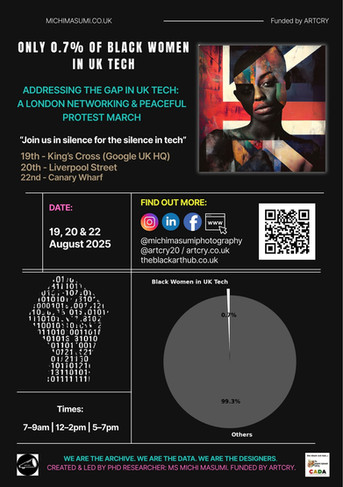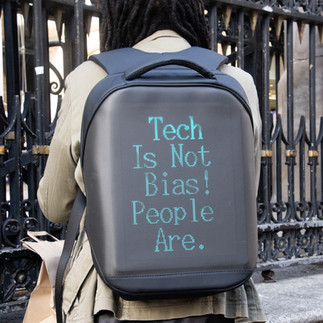Coded Out: 0.7% – Everything but Black Women
- Michi Masumi BA.MA

- Aug 21
- 8 min read
Updated: Sep 17
Digital Protest, Archival Resistance, and the Politics of Absence
Author: Michi Masumi.BA.MA
Date: August 2025
Funder: This protest was funded by ARTCRY
Locations: King’s Cross (Google HQ), Liverpool Street & Shoreditch, Canary Wharf
Keywords: Protest Anthropology, Black British Women, Digital Humanities, AI Bias, Archival Protest, Intersectionality
This document reflects on Coded Out: 0.7% – Everything but Black Women, a three-day protest staged in London’s digital corridors. The protest confronted the erasure of Black British women in the UK technology workforce (0.7%) through embodied performance, wearable technology, and digital art. This blog zine documents protest methods, theoretical grounding, and future directions, preserved as an archival record within the Benjamin Zephaniah Digital Online Library.

Disclaimer
This was a peaceful and lawful protest, carried out in public spaces without obstruction or confrontation. The actions documented here involved silent presence, wearable digital art, and the distribution of printed leaflets/QR codes. No property was damaged, no public rights of way were blocked, and no illegal activity took place.
The focus of Coded Out: 0.7% – Everything but Black Women was on visibility, awareness, and dialogue, aligning with traditions of non-violent protest and artistic intervention.
This protest was made possible through funding from ARTCRY, a live fund supporting urgent artistic responses to social and political events. Their support enabled the rapid staging of Coded Out: 0.7% – Everything but Black Women, ensuring that artistic protest could meet the urgency of systemic exclusion in the UK technology sector.
Introduction: Protest as Archive
The absence of Black British women from the UK IT sector is not incidental; it is systemic. Only 0.7% of the workforce is Black women. This number, both statistic and scar, was the starting point for my protest.
As bell hooks (1992) reminds us, “looking is also a political act.” My protest insisted that Black women be seen, in data, in public, in digital futures. By staging a protest in spaces of tech power, my body became a data point: a live archive of exclusion and resistance.
A Digital Protest for Visibility and Justice
Last week, I staged a three-day protest titled Coded Out: 0.7% – Everything but Black Women at the very heart of Britain’s technology industry: King’s Cross (Google HQ), Shoreditch (London’s tech district), and Canary Wharf (fintech headquarters).
The protest addressed one unignorable fact: only 0.7% of the UK IT workforce are Black women. This is not a minor statistic; it is evidence of systemic exclusion, a silence coded into the digital future of Britain.
Through wearable technology, digital art, and embodied protest, I demanded that this absence be seen, felt, and challenged.
Why March?
As an UK Black AI and digital artist, and PhD Tech anthropology researcher, I have personally experienced gatekeeping and barriers in relation to accessing the UK's Tech sector. I struggle to see representation that looks like me. Where are the UK Black Women in Tech and GAI (Generative Artificial Intelligence)? especially those leading projects. I have real concerns about both algorithmic bias and the current AI guidelines within the UK including global third-party technology, which have again excluded the very people that the bias impacts on a daily basis.
“Only 0.7% of the UK IT workforce are Black women. Absence is political.”
“Silence can be disruptive. Presence is resistance.”
“The master’s tools can be used to fracture the house from within.” – Audre Lorde
“Representation is about who gets seen, who gets erased.” – Stuart Hall
“Algorithms don’t just reflect bias — they reproduce it.” – Ruha Benjamin
Why This Protest Matters
The digital economy is reshaping every aspect of our lives, from healthcare and education to art and identity. Yet, as Safiya Umoja Noble (2018) argues in Algorithms of Oppression, search engines and AI systems often reproduce and amplify racial and gender bias. Ruha Benjamin (2019) builds on this in Race After Technology, showing how coded systems can embed exclusion under the guise of neutrality.
In real time, this embedded excusions is very evident on social media platforms, within AI prompts software and apps, we know this is also demonstrated with face recognition products.
Preparation as a Research Method
Preparation was not just logistics — it was methodology. Each element of protest design was intentional:
LED Backpack: symbolised data visibility and cyborg identity. The binary code loop became both language and barrier. An archive of absence displayed in public.
Digital presentation with protest slogans, using digital software and tools to raise awareness of a digital and social issue:
The protest was not only about archiving absence, it was also about recognising that we, the protestors, (Black British women) are the living archive. Our bodies, actions, and refusals become records for future researchers to study, and reminders that visibility itself is a form of preservation
Pancras Sq, London (19th August 2025)
Clothing (all black): a uniform aesthetic signalling presence without distraction, drawing attention to absence.
Protest Flyer + QR Codes: created a hybrid archive. Physical leaflets invited tactile interaction, while QR codes opened digital pathways to further research.
Protest Choreography: silence, stillness, and minimal gestures created a contrast against the noise of urban spaces.
Locations: chosen for symbolic weight.
Google HQ: algorithmic power and global tech control.

Shoreditch: London’s so-called innovation district.
Canary Wharf: financial and AI hiring hub.
Small Team as Methodology: Each day’s action was carried out by a team of three. This was a deliberate choice:
to emphasise visibility through presence rather than numbers,
to maintain a peaceful and lawful environment,
and to enable close ethnographic observation of public responses.
As Sara Ahmed (2012) argues, feminist protest often disrupts institutional happiness. Preparation was a form of willful resistance: crafting tools to break the flow of business-as-usual.
Day One – Google HQ (19th August)
King’s Cross: questioning who writes the code and who is written out.
Google symbolises both global innovation and algorithmic exclusion. Standing outside the King’s Cross HQ with an LED backpack flashing binary code, I embodied what Stuart Hall (1997) described: the struggle over representation.

Key Question: Who gets to define meaning in the digital world? Who writes the code, and who is written out?

Protestor 02 outside Google London
Day Two – Liverpool Street & Shoreditch
(20th August)
Shoreditch: innovation cannot be built on exclusion.
In Shoreditch, the “innovation district,” my protest disrupted the myth of inclusivity. Tech founders and investors witnessed what Ruha Benjamin (2019) terms the “New Jim Code” — technologies that reinforce exclusion under the guise of neutrality.
By handing out leaflets and inviting QR scans, I enacted a micro-archive of participation, refusing silence.
Day Three – Canary Wharf (22nd August)
Canary Wharf: fintech futures must include Black women.
At Canary Wharf, the heart of fintech and AI hiring, I confronted institutional decision-making. Wearing black, standing against towers of glass, I enacted Audre Lorde’s (1984) strategy of subversion: using the master’s tools — wearable LED screens, binary protest, AI art , to fracture the house from within.
Today, security asked us to leave the premises and insisted that we stay across the bridge. We left peacefully. Ironically, security drew more attention to our presence by approaching us, which in turn helped the cause of the protest, amplifying visibility and inviting further public curiosity.
*Fintech means: A company uses technology to provide innovative financial products and services, making finance more accessible, faster, and often more convenient for consumers and businesses. The term combines "financial" and "technology" and describes businesses that use software, mobile apps, AI, and other advanced tools to deliver services like mobile payments, online banking, digital lending, and investment platforms, often disrupting traditional financial systems.

Protest as a Research Method
This work is inseparable from my PhD: Art, Activism, Aesthetics and AI: Black, British & Female.It extends the Anthro-Digital Narratives (ADN) framework, where lived experience, digital disruption, and archival practice intersect.

Intersectionality (Crenshaw, 1989): Black women’s exclusion in tech is compounded across race, gender, and class.
Oppositional Gaze (hooks, 1992): The protest looked back at audiences, forcing confrontation with absence.
Algorithmic Oppression (Noble, 2018): By blending my portraits with AI tools, I reclaimed visibility in spaces where algorithms erase us.
Archival Resistance (Benjamin, 2019): The protest becomes an archive, stored here in the Benjamin Zephaniah Library, challenging future historians to reckon with omission.
Willful Subjects (Ahmed, 2012): Refusing compliance, the protest embodied willfulness — disrupting expectations of silence and invisibility.
Field Observations (Ethnographic Notes)
Commuters at King’s Cross: many glanced quickly and turned away; others stopped, photographed, or whispered. This tension between avoidance and curiosity is ethnographic data of discomfort.
Liverpool Street & Shoreditch tech workers: more QR scans, some asked questions about “why 0.7%?” One comment: “I’ve never thought about who’s missing from tech.”
Canary Wharf professionals: more avoidance, faster walking pace, but symbolic weight was highest here — silence met silence.
Each response — glance, photo, avoidance — became live ethnography, reinforcing that protest is a form of research method.
Below - Photo Credits: Kevin Paul Lawrence
What Was Learned
Silence can be louder than noise.
Presence is political.
Public response is ethnographic data.
Technology can be weaponised against its own exclusions.
This protest must continue for real change to occur.
Interesting Facts
I travelled over 240 miles
We did 17 hour days
Timeline of Protest Actions
19 August – Google HQ (King’s Cross)Focus: Algorithmic power.Method: LED binary protest.
20 August – ShoreditchFocus: Innovation myth.Method: Zine distribution + QR scans.
22 August – Canary WharfFocus: Fintech + AI hiring bias.Method: Silent presence against financial towers.
Glossary
0.7%: The proportion of Black women in the UK IT workforce.
ADN Framework: Anthro-Digital Narratives, a methodology combining art, ethnography, and digital disruption.
Digital Protest: Use of digital tools (LED, QR codes, AI art) as activism.
Oppositional Gaze: bell hooks’ term for resistant looking.
Archival Resistance: Using the archive itself as protest, preserving erased voices.
Archival Assets
Protest information Leaflet (PDF)
Protest Headliners (protest slogans): Embedded in this archive as a portable manifesto.
Photographic Documentation: To be stored alongside this blog (images of protest days, LED screen, handouts).
Video Snapshots:
Conclusion: The Archive as Future
This protest is not a closed event. It is a replicable method, a portable archive, and a demand for systemic change. With further funding, I would like to annually attend AI and Tech conferences to raise awareness until real change is made.
Preserving this record in the Benjamin Zephaniah Library is both an act of resistance and an invitation to future researchers and protestors:
This protest was funded by ARTCRY.
This work demonstrates that rapid-response funding is vital for activist art. Without ARTCRY, this protest and the living archive it created would not have been possible.
Bibliography
Ahmed, S. (2012) On Being Included: Racism and Diversity in Institutional Life. Durham: Duke University Press.
Benjamin, R. (2019) Race After Technology: Abolitionist Tools for the New Jim Code. Cambridge: Polity.
Crenshaw, K. (1989) ‘Demarginalizing the Intersection of Race and Sex’, University of Chicago Legal Forum, 1989(1), pp. 139–167.
Hall, S. (1997) Representation: Cultural Representations and Signifying Practices. London: Sage.
hooks, b. (1992) Black Looks: Race and Representation. Boston: South End Press.
Lorde, A. (1984) Sister Outsider: Essays and Speeches. Freedom, CA: Crossing Press.
Noble, S.U. (2018). Algorithms of Oppression: How Search Engines Reinforce Racism. New York: NYU Press.
Shilliam, R. (2018) Race and the Undeserving Poor: From Abolition to Brexit. Newcastle: Agenda Publishing.
Tate, S. (2015) Black Women’s Bodies and the Nation: Race, Gender and Culture. London: Routledge.
ARTCRY (2025) Live fund for urgent artistic responses. Available at: https://www.artcry.co.uk/
.png)
.png)













































Comments